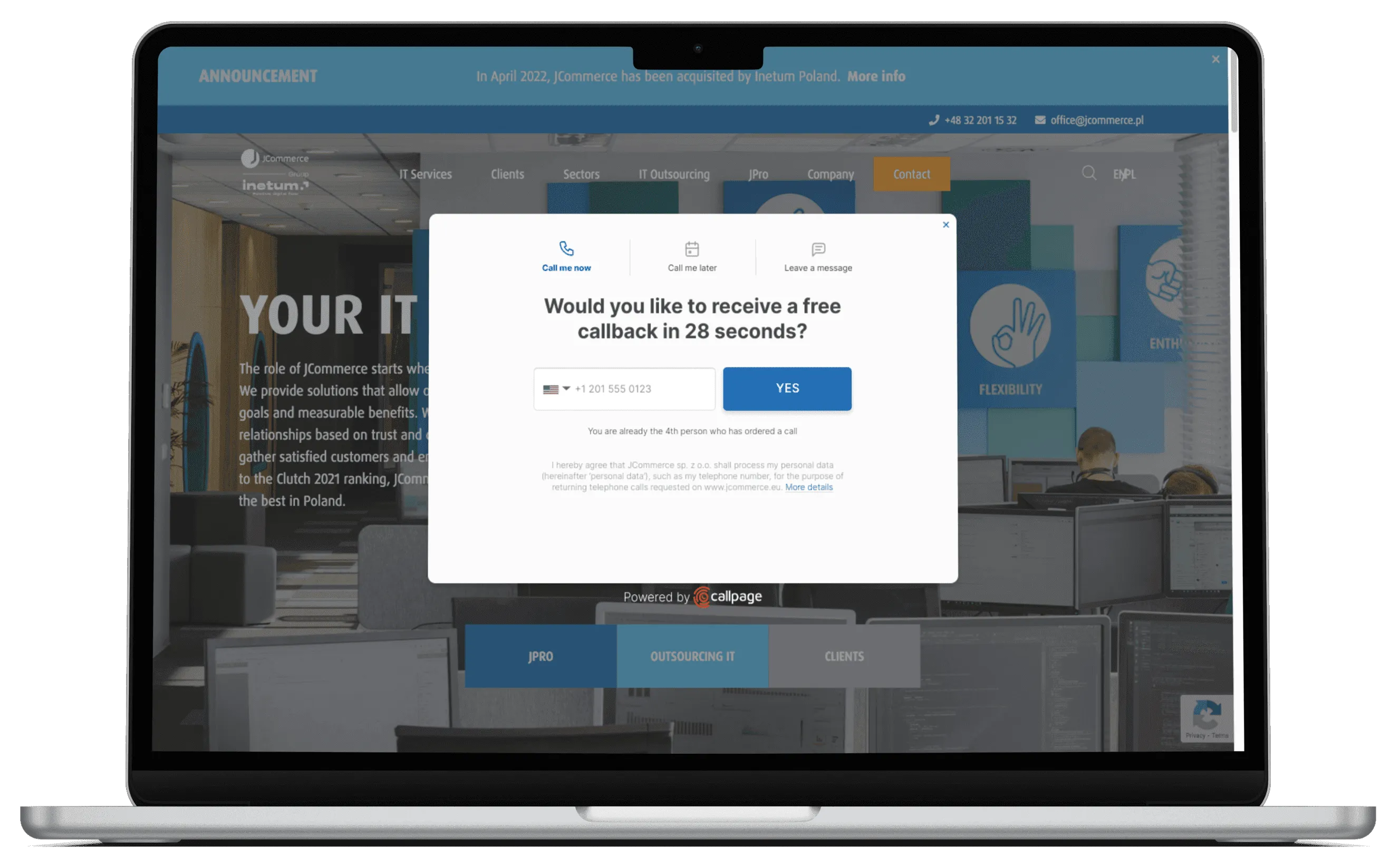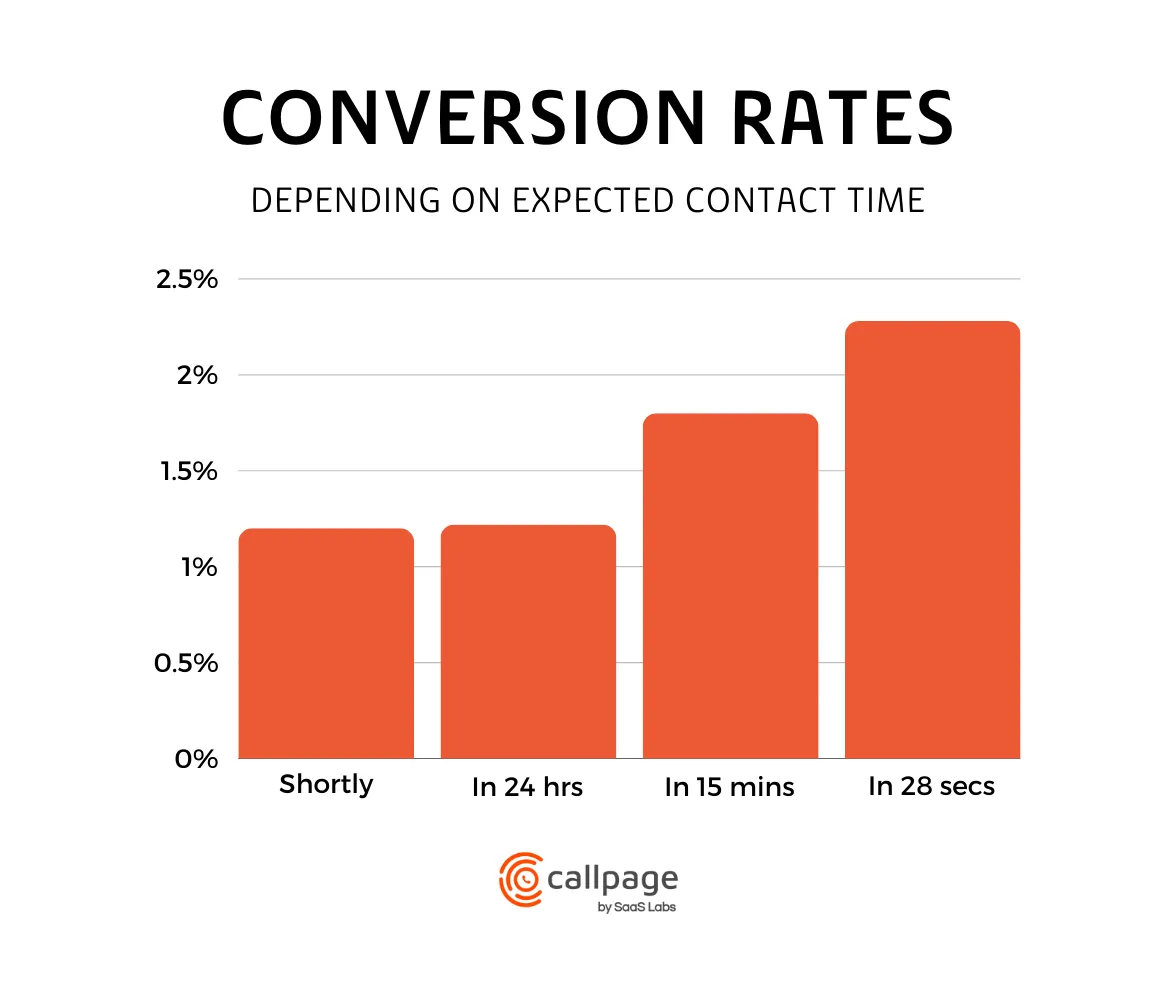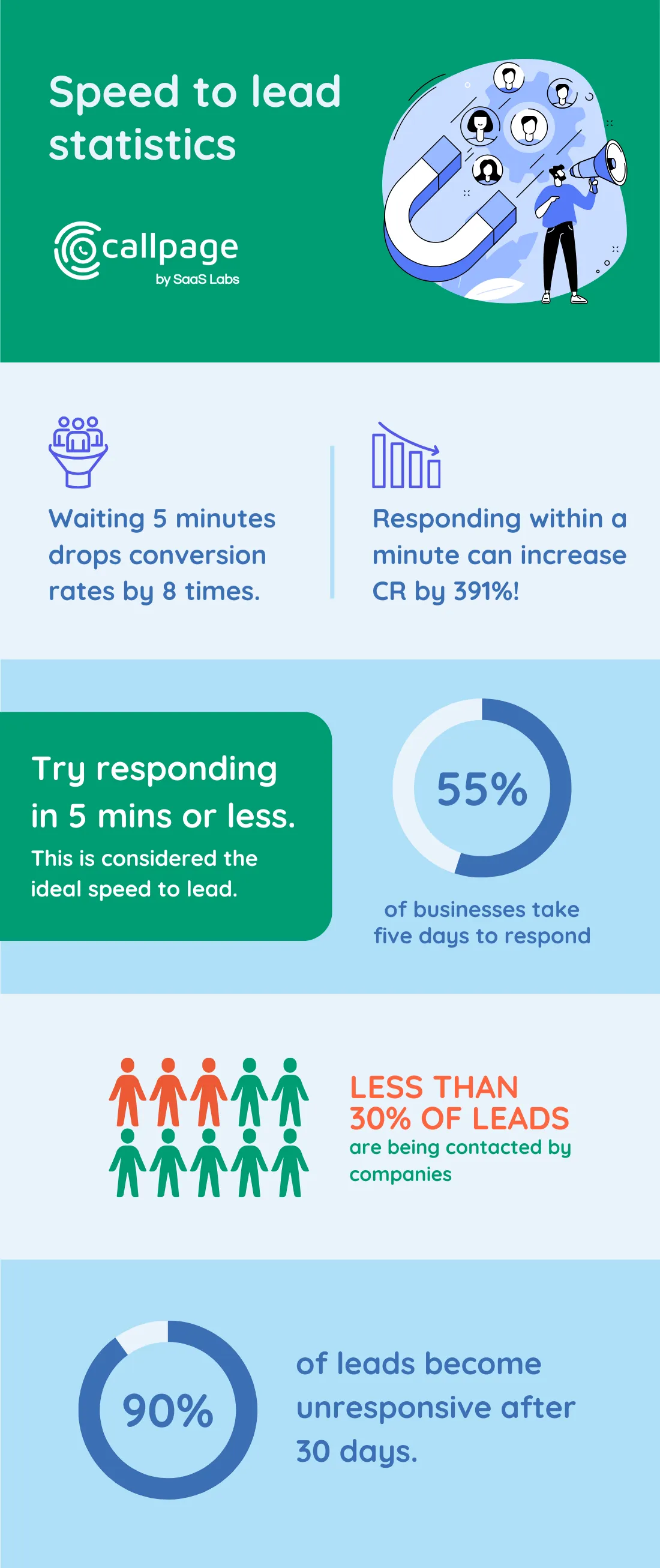
Speed to Lead: A Key Metric for Increasing Sales (+Statistics)
Want to boost your sales? Learn what 'speed to lead' is all about and why it's a game-changer. Get simple tips and key stats to turn leads into sales faster!
Contents
Time is everything in sales. The faster your team can get back to potential customers, the better. It can make a huge difference in how many leads you convert into customers, how happy your customers are, and even how much money your business makes.
In this blog post, we're going to dive into the idea of "speed to lead". We'll talk about why it's so important, the challenges you might face, and how to overcome them. We'll also share some tips and success stories to help you get a handle on this crucial part of sales.
Speed to Lead in a Nutshell
- "Speed to lead" is just a fancy way of saying how fast your salespeople get back to potential customers. It's super important for improving your conversion rates and making your customers happy.
- A lot of research which we will discuss shows how focusing on fast responses can lead to more money coming in and happier customers.
- Using automation tools can help speed up your response time. This means you can beat your competitors to the punch by automating the process of qualifying leads.
What Is Speed to Lead?
Speed to lead is the time your sales reps need to contact leads after they've shown interest in your business. It's the time gap between a prospect filling out a contact form on your website and your team reaching out to them.
In today's fast-paced business world, responding swiftly plays a very important role in converting leads. Many studies and statistics, which we will get into later, indicate that your speed to lead (also called the lead response time or time to lead) has a direct and notable influence on the lead conversion rate.
So, how can you make sure you're on top of your speed to lead? Here are some actionable strategies:
- Monitor your team's response rates. Keep an eye on how promptly your team responds to incoming leads.
- Track the complete lead journey. Follow your leads from their initial contact through their entire interaction with your business.
- Find the ideal response time. Work out a response speed that keeps your prospects interested without feeling rushed.
- Identify and address sales process hurdles. Look for any obstacles or sticking points in your sales process and find ways to smooth them out.
- Improve lead response time. Continually work on reducing the time it takes to respond to leads.
- Boost lead-to-customer conversion rates. By improving response times, you increase the likelihood of turning leads into paying customers.
Implementing these steps can make a significant difference in your lead management and overall sales success.
READ ALSO: How to Decrease Lead Response Time and Boost Sales in 5 Actionable Steps.
The Importance of Speed to Lead
Speeding up how fast you get back to potential customers is a game-changer for your sales. Here's what you get:
- Better Chances of Making a Sale: Quick replies mean you're more likely to turn a maybe into a yes.
- Happier Customers: People love it when you answer fast. It shows you care and are ready to help.
- Cooler Brand Image: When you're quick to respond, people start thinking your brand is on the ball and reliable.
- More Money in the Bank: The faster you respond, the more sales you're likely to make. And that means more profit.
Here's the thing: if you're the first to answer a customer's question, they're probably going to buy from you. About 78% of customers go with the business that gets back to them first, according to LeadConnect. So, if you're quick to respond, you're not just answering a question; you're winning a customer. That's why getting back to people fast can really help your sales team turn those leads into cash.
Lead Response Time Challenges
Speed to lead can be a tough nut to crack for many businesses. The big hurdles? No automation and messy lead distribution. These issues can mean lost customers, missed chances, and a not-so-great customer experience.
But don't worry! We're going to dig into these challenges and give you some solutions to help you up your response game!
READ ALSO: How to Decrease Lead Response Time and Why Should You Do It
The automation problem
When you're handling leads the old-fashioned way, things can easily go wrong. You might find yourself bogged down with:
- Hit-or-miss lead qualification. Without a consistent system, deciding which leads are worth pursuing can be a guessing game.
- Never-ending data entry. Typing in details for every lead? That's a surefire way to eat up your time and patience.
- Poor communication with customers. When you're swamped, personalized communication takes a back seat, leaving your responses feeling a bit robotic.
- Disorganized data. Without a proper system, your valuable lead information can end up scattered and hard to use effectively.
Here's the good news: automation can turn this around. There's a whole world of software out there designed to make lead management a breeze. These tools are not only quicker but also more precise than manual methods, ensuring no lead slips through the cracks.
Many of these tools can also rev up your response times by automatically handling initial lead interactions. But here's the million-dollar question: how do you keep automated communication feeling personal?
When it comes to email automation, for instance, many platforms allow you to customize your messages. They use recipient data like their name, location, or interests to tailor each message, making automated emails feel more like they're coming from a human than a robot.
But if you want to take it up a notch, that's where CallPage comes into play. Our tool automatically captures leads from your website and instantly connects them with your sales reps via phone, typically in less than 28 seconds. Plus, if a lead prefers to schedule a meeting or call for a later time, CallPage can handle that too — all automatically, without any manual intervention.
What sets CallPage apart is how it blends the convenience of automated lead generation software with the personal touch of real conversations. Your leads get the quick response they're looking for and the personal connection they need, setting the stage for a more successful sales interaction.
The lead distribution dilemma
Navigating lead distribution can feel like a bit of a juggling act, but it's key for keeping your sales process smooth. When it's isn't handled right, you might face a few bumps in the road:
- If leads don't land in the right hands quickly, it can leave your customers feeling a bit neglected.
- Not managing leads properly means you could be missing out on some golden sales opportunities.
- When lead distribution is all over the place, it can slow down your whole sales cycle (including speed to lead).
- Misdirecting leads means your team's time and effort aren't being used as well as they could be.
So, what's the fix? It's all about having a solid lead distribution software platform or system in place. This means getting each lead to the right sales rep quickly, based on things like where they're located, what they're interested in, or what they need. This keeps things running smoothly and makes sure your customers are chatting with the best person for their needs.
And guess what? CallPage Meetings is your ticket to getting this right. Our system intelligently routes leads to the most suitable team member based on the department they're aiming to connect with and a variety of responses from fully customizable forms. It's like having a super-efficient traffic controller for your leads.
Tips to Boost Your Speed to Lead in a Sales Team
To improve your speed to lead, there are several strategies you can implement:
- Automate responses and workflows
- Use standardized response templates to speed up response times
- Prioritize high-potential leads
- Monitor and track performance
Automating responses & workflows
Let's talk about when someone sends a message to your sales or customer support folks. They're usually expecting a quick response, right? In fact, about 90% of customers desire an immediate response from customer service, and 60% define "immediate" as within 10 minutes or less (source: EmailAnalytics)
Now, we know your team can't be on standby 24/7. But having an automated message pop up like, "Got your message! We'll get back to you by [insert time here]" can really set minds at ease.
It's a good move to at least confirm that their message hasn't disappeared into the digital void. No confirmation can lead to more messages, and that's when things start getting messy.
And hey, if you say you'll reply by a certain time, make sure to keep that promise.
For those routine inquiries that don’t require personalized attention, chatbots and automated replies are invaluable. They not only provide instant answers but also free up your team to handle more complex queries.
Implementing standardized response templates
Imagine your team is swamped with 500 messages, but you notice that about 80% of these are essentially the same three questions, just worded differently. It's inefficient to craft individual responses each time. This is where standardized response templates come into play.
Here's how you can design these templates:
- Identify Common Queries: Start by categorizing the most frequently asked questions.
- Craft Clear Responses: Develop concise and clear responses for these categories.
- Personalize When Possible: Include placeholders for personalization to avoid sounding robotic.
Remember, just because a response is standardized doesn't mean it has to sound robotic or impersonal. Steer clear of being too generic and make sure each response is tailored to address the specific query at hand. It's a good idea to infuse a bit of personalization into your templates, ensuring your customers feel valued and not just like another ticket number.
Even in a world of automation and standardization, keeping a touch of the human element in your communications is key.
READ ALSO: Why H2H Marketing is the New Black in the Business World
To get the most out of these templates, remember about:
- Regular Updates: Keep the templates up-to-date with the latest information and policies.
- Training Staff: Ensure your team knows how to use and when to deviate from the templates.
- Monitor and Adapt: Regularly review the effectiveness of the responses and make adjustments as needed.
Prioritizing high-potential leads
Alright, so you've got your responses and templates ready to rock. But what about those leads that are just, you know, more promising than the rest? According to the Pareto rule, 20% of customers are responsible for 80% of your revenue. So those 20% of leads need a little extra attention.
Speed to lead is crucial here. The faster you respond to these high-potential leads, the higher your chances of converting them into actual customers.
So, when your system flags a lead as high-potential, it's time to switch gears. Skip the standard automated response and go for something more personalized. This doesn't mean you have to write a novel for each reply, but a response that acknowledges their specific needs or interests can make a huge impact.
And it's not just about being quick. It's about being smart, too. Use the information you have about these leads to tailor your responses. Personalized, prompt replies show that you're not only fast but also attentive to their needs.
To spot leads with the most potential in sales and give them the right care, you should:
- Use a lead scoring system to identify high-potential leads based on their interactions or demographic information.
- Set up immediate notifications for when a high-potential lead is identified.
- Train your team to respond quickly and effectively to these qualified leads.
- Personalize responses to address the specific needs or interests of the lead.
- Use CRM tools to store, access, and utilize lead information for personalized responses.
Monitoring and tracking performance
Making sure your strategies are working well means keeping an eye on how things are going. It's not just about setting up automatic replies, templates, and focusing on leads with big potential. You also need to regularly check how these approaches are doing.
If you don't, how will you figure out if your efforts are paying off and spot any areas that need improvement?
Besides monitoring speed to lead statistics themselves, it's also important to track:
- Outbound to inbound lead count. A higher inbound ratio indicates effective marketing, while strong outbound reflects active engagement. This helps fine-tune lead generation strategies.
- Conversion rate. This figure reveals what proportion of your leads turn into customers. A higher conversion rate is a good sign that your sales tactics are working. If it's lower, it might be time to rethink your strategies.
- Average deal size. This gives you an idea of how much revenue you're making per sale. Bigger deals often mean you're nailing upselling or effectively targeting more lucrative markets.
- Sales cycle length. This is the typical duration from lead to customer. Shorter cycles suggest your sales process is streamlined and effective. Longer cycles can happen with more complex products or particular types of clients.
- Customer acquisition cost (CAC). Implied in your metrics, this is the expense of gaining a new customer. A lower CAC points to more cost-effective marketing and sales efforts.
Technology's Role in Improving Speed to Lead

Automating lead capture and distribution among sales reps
Automating lead capture and distribution is a key strategy for improving speed to lead. By utilizing tools like CallPage, businesses can instantly capture inbound leads directly from their website. This process eliminates manual data entry and ensures that leads are quickly routed to the appropriate sales representatives.
Imagine a visitor lands on your website, interested in your product. Instead of filling out a lengthy form, they're greeted by a tool like CallPage. It swiftly captures their info and, within less than 30 seconds, connects them to a sales rep. This is crucial because, according to a Harvard Business Review study, businesses that contact potential customers within an hour of receiving a query are nearly seven times more likely to qualify the lead than those who waited even an hour longer.
But it's not just about speed. This automation also means better lead management. Leads are distributed evenly among your sales team, preventing anyone from being overwhelmed and ensuring every potential customer gets timely attention. Plus, for those who aren't ready for an immediate chat, they can easily schedule a call or leave a message, which is especially handy after hours.
Personalizing customer experience with callbacks
Now, onto personalizing the customer experience. This goes beyond just using a customer's name (though that's important too!). It's about creating a connection.
For example, if a customer has previously interacted with your business, recalling details from that interaction can make them feel valued and understood. This level of personalization can significantly impact customer satisfaction and loyalty.
Personalized callbacks are a prime example. Unlike automated emails or generic messages, they provide a unique opportunity for real-time, two-way communication. This means your sales team can immediately address specific customer needs, suggest tailored solutions, and build stronger, more personal relationships. It's a powerful way to stand out in a crowded market.
Integrating chatbots for efficiency
For a more automated, less hands-on approach, consider a chatbot. It's a good fit for B2C businesses like online clothing stores. On the other hand, if your leads are fewer but more valuable, needing extra care, such as in B2B scenarios, instant callbacks are the way to go.
Chatbots, powered by sophisticated AI, can provide instant responses to frequently asked questions, improving speed to lead around the clock. This isn't just about convenience; it's about efficiency. A study by
revealed that 69% of consumers prefer chatbots for quick communication with brands.
These AI assistants are fantastic at handling initial inquiries, qualifying leads, and even setting up appointments. They ensure a smooth transition from initial contact to human interaction, allowing your sales team to focus on more complex tasks and leads that require a personal touch.
Speed to Lead in Action: Our Experience at CallPage

A while back, we did a little experiment at CallPage to see how callback times could shake up our conversion rates. When we promised to call back within 28 seconds on our landing page, we saw a 2.28% conversion rate.
That's a big leap compared to the other pages – one with a vague "call back soon" promise only managed to scrape together a 1.2% conversion rate, and another promising a callback in 24 hours just hit 1.22%. Even the one promising a 15-minute callback was slightly lower at 1.8%.
The results aren't surprising. They're just another piece of evidence indicating why speed to lead is such an important metric.
Almost doubling our conversion rate is a big deal for us. It all boils down to showing potential customers that we respect their time and don't want to keep them on tenterhooks. This tactic of getting back to people pronto really helps keep potential clients on the hook and stops them from checking out the competition.
Other Spead to Lead Statistics

Lead Response Management study
Overview: This study, conducted by Dr. James Oldroyd from MIT, analyzed 15,000 leads and 100,000 call attempts over three years.
Findings: The study revealed that the odds of contacting a lead decrease by over ten times in the first hour. Moreover, the odds of qualifying a lead are 21 times higher when contacted within 5 minutes compared to 30 minutes after an inquiry.
Source: Lead Response Management Study
Harvard Business Review analysis
Study: Harvard Business Review analyzed over 2,200 U.S. companies' response times to web-generated leads.
Key Finding: Companies that tried to contact potential customers within an hour of receiving a query were nearly seven times as likely to have meaningful conversations with key decision-makers as firms that waited even an hour longer.
Source: Harvard Business Review
Conversica research
Research: Conversica conducted a study on speed to lead and its impact on conversion rates.
Insight: The study revealed a significant decrease in lead conversion rates with increasing response times. Specifically, within 5 minutes, the conversion rate is around 70%. This rate drops to about 50% within 30 minutes, approximately 20% within 1 hour, and drastically falls to around 5% within 24 hours. After 24 hours, the conversion rate further declines to about 2%.
Source: Conversica Research
Let's sum up
So, what's the bottom line here? Speed to lead is a game-changer in sales. It's not just about being quick; it's about being efficient and personable at the same time.
By automating responses and workflows, using standardized response templates, and prioritizing high-potential leads, you can seriously up your sales game. Tools like CallPage are a big help in this arena, offering instant callbacks and personalized customer interactions.
Remember, the faster you respond and follow up, the more likely you are to convert those leads into sales. Quick replies mean happier customers, a cooler brand image, and more money in the bank.
Focusing on speed to lead is a simple yet powerful strategy that can lead to big wins for your business.
Start generating leads today!
Start a 14-day free trial now,
set up the widget on your site, and see how many more leads you can capture with CallPage
- No credit card required
- 10 minutes set up
- 14 days fully-features free trial